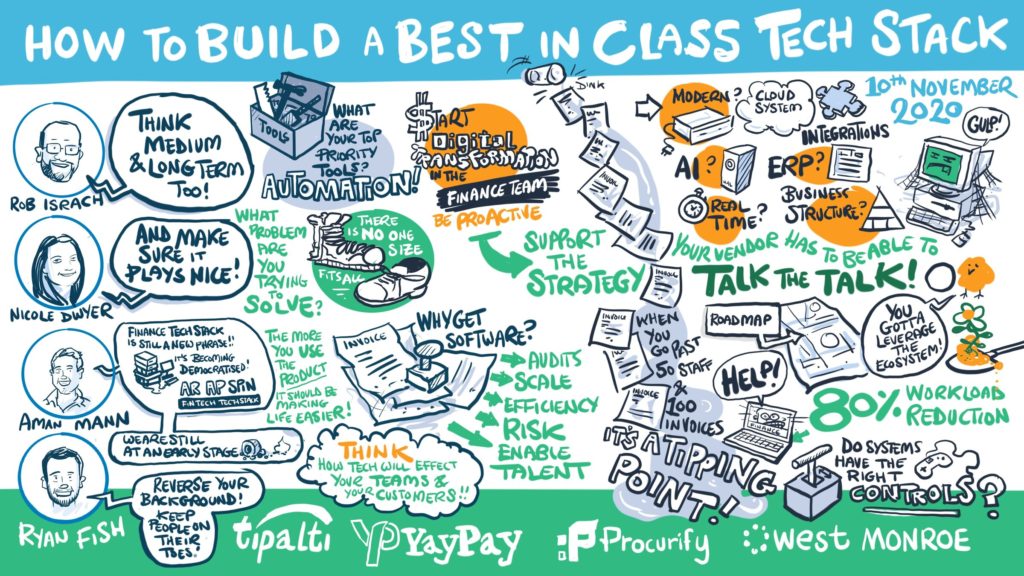In Case You Missed It – How to Build a Best in Class Finance Tech Stack

In this session, we learned about creating a best-in-class finance technology stack, no matter what stage your company is in.
According to the audience poll at the beginning of the event, when looking at new fintech tools, the following features are top of mind:
- Automation features
- Integration features
- Features that bring strategic value
Featured Speakers
Ryan Fish, Consulting Manager at West Monroe Partners
Ryan Fish works at West Monroe Partners, a business and technology firm working with organizations to create quantifiable financial value for their clients, and he moderated the event with finesse.
Aman Mann, CEO at Procurify
Aman Mann is on a mission to modernize business spend. He discusses how to use technology strategically and explains how Procurify makes business spending smart and simple. Mann is passionate about empowering teams by giving them the tools and information they need to make quick decisions.
Rob Israch, CMO at Tipalti
Rob Israch has been with Tipalti for six years, and he was with NetSuite for eight years prior. Tipalti focuses on automating and modernizing accounts payable. Rob provides tactical information on how to evaluate tools and when they should become a priority, depending on a company’s lifecycle stage.
Nicole Dwyer, CPO at YayPay
Nicole Dwyer enjoys solving problems in B2B payments and accounts receivable. She’s been doing just that for the majority of her career. The company she represents, YayPay, delivers an end-to-end accounts receivable solution that improves productivity, predictability, and transparency on receivables.
Key Takeaways from the Panel Discussion
There’s a lot to learn in this panel discussion about building a best-in-class finance tech stack. Here are some of the key takeaways:
- Finance tech stacks are becoming more complex. Today, it’s harder than ever to evaluate which tools are best for your organization. The main reason to get technology is to make life easier for your customers and teams.
- Digital transformation has occurred because there’s a need for control, agility, and growth.
- Best-in-class is better than one size fits all. When you are looking for a tech solution, it should be about solving a problem, not searching for what tools have the most features.
- To begin building a finance technology stack, start with your accounting system or ERP and build on top of it.
- Look for tipping points as a signal to when you may need to add in new software.
- When evaluating systems, look for case studies, reviews, and customers that are similar in size and industry to yours.
Integrations are crucial to your finance technology stack. Look at each tool separately and evaluate how they integrate together. It’s important to know what platforms are investing back into their product. The vendor should be confident enough to talk about the integration with ease and should coach you through the process. Look at the best-in-breed and who you want to build a relationship with. After all, integrated partners are an ecosystem that you are buying into.
When searching for new finance technologies, focus on these key performance indicators:
- Cost KPIs
- Productivity KPIs
- Efficiency KPIs
- Cycle-time KPIs
Best Practices for Rolling Out New Technology to Employees
“Start with why and be transparent on why you need it, and communicate that to the team. We tend to jump into the product too much. It’s usually say oh, here’s a problem let’s throw a product at it. If the why isn’t critical and the team isn’t bought in – it’s going to be hard to get that delivery especially if it is not user-friendly. The more you use the product, it should make your team’s life easier, and not the other way around. Make sure you have a champion and stakeholder are brought in for the entire process.”
– Aman Mann, CEO at Procurify
“Try starting with a pilot. Think of what should be first, what is the burning problem that you have, and what needs immediate relief? Especially if you have a list of problems, you need to be able to prioritize.”
– Nicole Dwyer, CPO at YayPay
“Ask the vendor what their process is for implementation, they should be able to articulate that. Also what type of talent they have surrounding the implementation and who would be able to support you. I would definitely ask this question when it comes to evaluation.”
– Rob Israch, CMO at Tipalti

